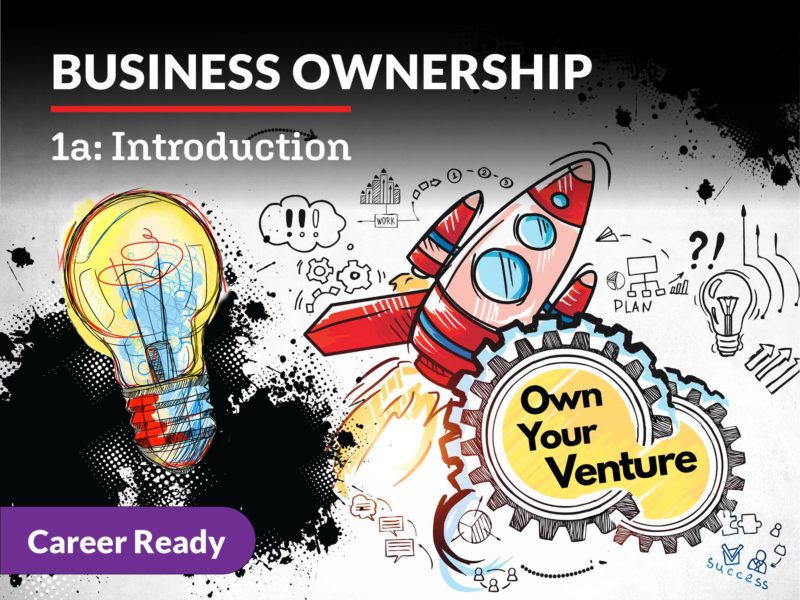
Business Ownership 1a: Introduction
Do you dream of a future where you can have creative freedom, working in an industry you love, where you can get up every morning excited about the day will bring? In this course, you’ll learn the skills you’ll need in order to take your dream and transform it into a successful business. You’ll explore foundations like generating ideas to qualifying opportunities, analyzing the market, and identifying skills for successful deployment. You’ll learn to keep your business rolling and growing through effective workplace leadership and training while incorporating technological innovations to keep your business competitive. Are you ready to turn your dreams into reality? Let’s get goaling!
Units at a Glance
Unit 1: The Entrepreneur and Small Business Ownership
Have you ever wondered what it takes to own and run a business? Well, new businesses often start with just a single good idea and at least one person who is able to turn that idea into a money-making opportunity. Usually, an individual begins with a vision and then works to embark on the journey toward business ownership. Starting a new business can be extremely rewarding. For instance, you get to be your own boss and enjoy all the benefits of career independence. But it also has its challenges. When you think about it, every good or service you buy began with both an idea and at least one person who made that idea a reality. Taken together, these two factors form businesses that operate to create products and services. If this prospect appeals to you, business ownership could be a great fit for your future career—and it all starts with the first step: entrepreneurship.
What will you learn in this unit?
- Describe the role of an entrepreneur and identify common traits and characteristics shared by entrepreneurs
- Evaluate entrepreneurship and business ownership as potential career options
- Research examples of past and present entrepreneurs and the innovations they introduced to society
- Discover the importance of entrepreneurship and small business to the overall performance of the economy
Unit 2: From Business Idea to Opportunity
Every new business starts with an entrepreneur’s vision for a new or improved product or service. In order to be successful, the idea must be strong enough that customers will buy it and that the company can make a profit from those sales. Although a quality idea is the first step, the next steps—what you do with that idea—are just as important. This initial idea must then be shaped to ensure it’s a real business opportunity; that is, something customers want. Once you’ve honed the business idea into a business opportunity, then you can focus on developing the outline of the business to show how the company will operate. Prior to the launch of the business, you must research the new opportunity with a focus on customers, competitors, and a suitable location. Once you have confidently transformed your business idea into a business opportunity, you may be ready to launch.
What will you learn in this unit?
- Explain how entrepreneurs generate new business ideas and shape them to create feasible opportunities
- Analyze the external environment to evaluate success potential in the marketplace
- Identify the elements of a business model and explore how this helps to shape the components of the company
- Describe important resources available to help analyze the best location for a new business
Unit 3: Business Formation
At this point, you have a great business idea. You’ve done your research, and now it’s time to embark on business ownership and launch your company. But before you can make your first sale, you still must complete some important steps in the process. The format of your business, the legal structure, and business registration are necessary steps before you can begin to launch your business idea. Because there are different legal business formats and structures, it’s important that you know the impacts and potential benefits of each. These early decisions will have long-lasting effects on you, your business, and your customers. As you develop your market entry strategy, you’ll also want to think ahead to your market exit strategy. This will help you achieve your ultimate goals for starting a business.
What will you learn in this unit?
- Evaluate and compare various business formats
- Examine various forms of legal business ownership by assessing the implications of each
- Identify the sequence of legal and business steps required to create a new business entity
- Describe potential business launch and exit strategies while evaluating the advantages and disadvantages of each
Unit 4: Navigating Laws and Regulations
Governments and businesses work together in many ways. Businesses operate to make profits, and governments work to ensure that conditions are good for them to achieve this. When owning a company, you must be aware of various government regulations to follow at the federal, state, and local levels. There are a wide range of rules that include everything from business registration to tax on selling the business—and everything in between. Owners of all types of businesses in all industries should know and follow the rules—to the benefit of business, consumers, and society.
What will you learn in this unit?
- Describe how various government laws and regulations impact and guide business operations and ownership
- Identify regional and local licenses, permits, and regulations relevant to business ownership
- Determine the federal, state, and local taxes that are the responsibility of business owners
- Explain types of intellectual property and protective measures from competitors and consumers
Unit 5: Business Management and Leadership
Business owners must perform many roles within their companies in aspects that include both managing and leading. Good managers can coordinate employees to make the best use of the company’s resources. Good leaders can empower employees to strive for excellence. Because these two aspects of business are similar, but not the same, they are explored separately. When managing and leading the company, business owners rely on a combination of key skills and principles. These skills and principles include things like communication, negotiation, dealing with failure, and promoting positive ethics and sustainability. By demonstrating both effective management and leadership, business owners can build a strong team and drive that team, and the business as a whole, to success.
What will you learn in this unit?
- Explain the importance of business management and its key functions
- Describe the importance of business leadership and its key roles, which are required in a small business
- Identify the importance of business failure and ways that business owners can positively handle those failures
- Examine the importance and impact of ethics and sustainability in a business
Unit 6: People and the Organization
By now, you’ve launched your business and you’re working toward achieving your business goals. To do this, you’ll need to build a strong team. This means adding talented people to your company. By recruiting, organizing, training, and keeping excellent employees, you can give your business a competitive advantage against other companies in your market. By developing strong people-management practices, you can help build an effective team and grow your business. Finding the right employees, treating them well, training them, and providing good opportunities are the steps you’ll need to take when developing the most important resource for your company—your people.
What will you learn in this unit?
- Identify the key human resources functions required in a business
- Evaluate the various aspects of a new business’s organization plan with a focus on employees
- Describe how business owners recruit and hire new employees into the organization
- Determine different methods used to train and develop the people within the business
- Explain how leaders can motivate employees to achieve organizational success
Unit 7: Technology and Business
Business ownership involves more than interacting with and managing other people. As a business owner, you must also learn to engage with the ever-evolving realm of technology. Small businesses use technology to help them operate every day. Whether it’s computer hardware (laptops, tablets, and phones), software, networks, internet applications—or all of the above—new advances in digital computing provide great opportunities to small businesses. And, as technology develops, it has the potential to affect business owners in both positive and negative ways. When operating your business, you will want to discover which technologies are available to benefit your company—and you would be wise to invest in the tools that are best for your employees and the overall organization.
What will you learn in this unit?
- Identify key technology trends and tools that assist business owners
- Explain how establishing e-commerce is important for small businesses
- Evaluate technology-based communication methods that are effective for a small business
- Describe key factors in developing an effective company website
Unit 8: Business Growth
If you are a business owner and you’re actually generating some profits from your efforts, then you’ve already had a taste of the kind of success business ownership can bring. This kind of success may inspire you to explore new opportunities for your company. If you are like most people, this means you will focus on how to grow your business to produce higher returns. However, if growing your company is a priority, then it’s important that you pursue that goal in a cautious and disciplined way. Growth is good for most businesses, and it can make you more competitive in the marketplace. But growth that is too rapid or risky can quickly lead to business failure. By setting the right strategy for future growth and considering the many options available—either within the United States or internationally—you can set your sights on taking your small business to the next level.
What will you learn in this unit?
- Identify key strategies that can help a small business achieve growth
- Describe how growth can be effectively achieved domestically
- Evaluate various strategies for a small business to expand internationally
Required Materials
Physical
- Audio recording device
- Video recording device
- Pencil and paper
Software
- Word processing software
- Presentation software
- Online maps
- Spreadsheet software





